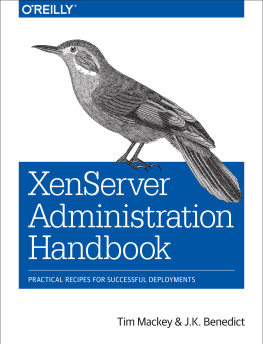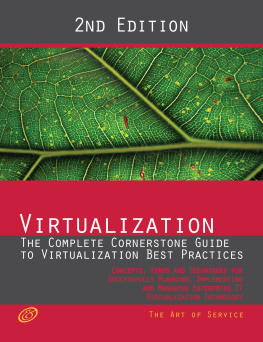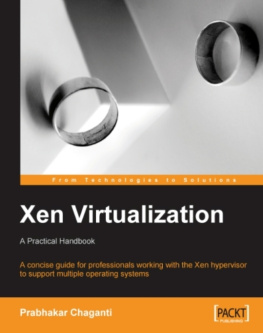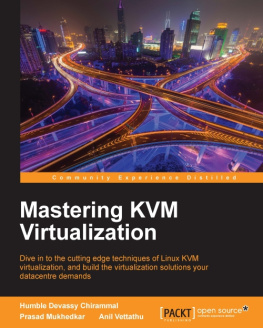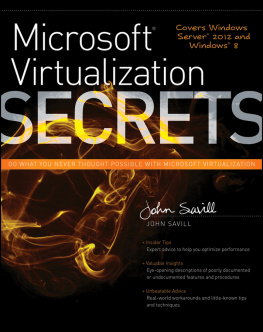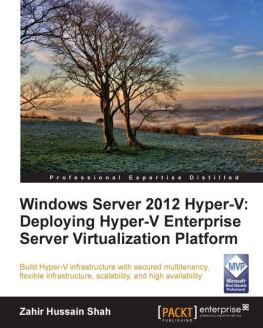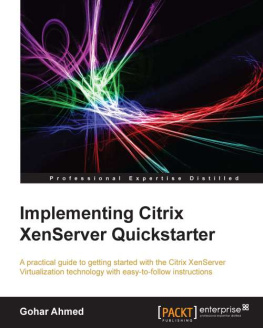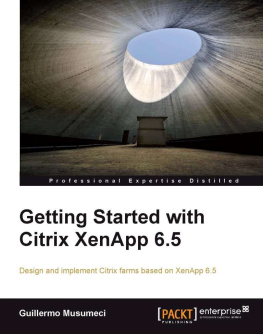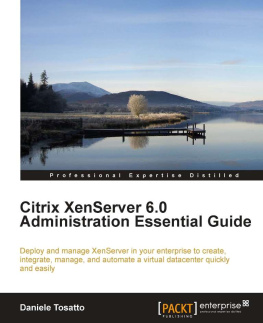XenServer Administration Handbook
by Tim Mackey and J.K. Benedict
Copyright 2016 Tim Mackey and J.K. Benedict. All rights reserved.
Printed in the United States of America.
Published by OReilly Media, Inc. , 1005 Gravenstein Highway North, Sebastopol, CA 95472.
OReilly books may be purchased for educational, business, or sales promotional use. Online editions are also available for most titles (http://safaribooksonline.com). For more information, contact our corporate/institutional sales department: 800-998-9938 or corporate@oreilly.com .
- Editor: Nan Barber
- Acquisitions Editor: Rachel Roumeliotis
- Production Editor: Shiny Kalapurakkel
- Copyeditor: Kim Cofer
- Proofreader: Amanda Kersey
- Indexer: Angela Howard
- Interior Designer: David Futato
- Cover Designer: Karen Montgomery
- Illustrator: Rebecca Demarest
- March 2016: First Edition
Revision History for the First Edition
- 2016-03-15: First Release
See http://oreilly.com/catalog/errata.csp?isbn=9781491935439 for release details.
The OReilly logo is a registered trademark of OReilly Media, Inc. XenServer Administration Handbook, the cover image, and related trade dress are trademarks of OReilly Media, Inc.
While the publisher and the authors have used good faith efforts to ensure that the information and instructions contained in this work are accurate, the publisher and the authors disclaim all responsibility for errors or omissions, including without limitation responsibility for damages resulting from the use of or reliance on this work. Use of the information and instructions contained in this work is at your own risk. If any code samples or other technology this work contains or describes is subject to open source licenses or the intellectual property rights of others, it is your responsibility to ensure that your use thereof complies with such licenses and/or rights.
978-1-491-93512-5
[LSI]
Preface
With more than 150,000 organizations running XenServer virtualization in a production environment, it is easily one of the most popular platforms available for virtual machine (VM) management. Since its inception as a research project of the University of Cambridge in 2001, the core Xen Project hypervisor has consistently pushed the boundaries of data center computing. The XenServer technology was acquired from XenSource in 2007 by Citrix, and the technology has evolved to support high-density virtualization for both cloud and desktop workloads.
XenServer furthered its leadership role when, in 2013, Citrix partnered with NVIDIA to deliver true hardware graphics virtualization using NVIDIA GRID and XenServer to define a new class of virtual workload: the high-performance graphics workstation. Even more recently, this new type of virtual workload has been expanded to leverage both Intel and AMD video cards for Windows- and Linux-based Guest VMs.
This is the environment XenServer administrators are increasingly being called upon to optimize and manage. This book seeks to provide practical guidance for how to plan, deploy, operate, and troubleshoot a modern XenServer environment. Our goal is that regardless of whether you manage a modest installation of a few blades or multiple global enterprise data centers, if youve found XenServer to be a critical component of your organization, then there will be valuable content for the successful operation of your XenServer deployment.
How This Book Is Organized
To easily fulfill the goals of this book, namely providing administrators with the information they need to be successful with XenServer, weve organized the content into two parts.
Part 1 covers the content most valuable during the design phase of a deployment. This is where youll find information on the architecture of XenServer, installation guidelines, best practices, and deployment blueprints. Some of the information in this portion of the book includes:
- Exactly what a XenServer is
- The critical components that make up a XenServer environment
- Installation of XenServer hosts
- Storage, network, and management paradigms
Part 2 covers day-to-day management information. Everything from log management through backup strategies are presented. The majority of the content in this section is provided in simple problem statements with easy resolutions. Its important to note that when resolutions are provided, the answer may include either XenCenter or command-line instructions. Most solutions will include the simplest path to resolution over presenting multiple solutions and going into detailed analysis of root causes.
Who This Book Is Written For
From seasoned compile-it-from-scratch Xen experts to college students maintaining a virtualized infrastructure in their spare time, this book was written with the specific purpose of making any XenServer administrator, experience aside, successful from installation to system-based lifecycle management.
No one person has ever climbed out of bed, headed into the office, and become a spontaneous XenServer administrator. Even we continue to learn from our colleagues and the Xen community; and we keep our own skills sharpened. It is this constant type of learning and problem solving that keeps us enthusiastic, driven, and energetic about XenServers power to create an infrastructure. It is all this and more that, in turn, we have presented within these pages: something new or something familiar to ensure you have a successful XenServer deployment story to share with others.
Future Release Information
This book was specifically written to cover XenServer 6.5. At the time of its writing, XenServer Dundee was under development, and pre-release installers were publicly available. Some functionality is expected to be changing in Dundee, but there is no guarantee the pre-release changes wont be changed prior to final release. Where changes are known to exist in a preview form, well let you know.
About Us
At heart, we are absolute tech geeks. We both enjoy working with the latest technology while solving some pretty cool problems. When working with customers or users, were both trying to find ways to quickly resolve whatever issue caused the customer or user to reach out for help. It is this passion for technology, coupled with an understanding for what it means to run software in production, that drove us to write this book. Put simply, we want every XenServer admin to be successful with XenServer, and this is one way to accomplish that goal.
Conventions Used in This Book
The following typographical conventions are used in this book:
ItalicIndicates new terms, URLs, email addresses, filenames, and file extensions.
Constant widthUsed for program listings, as well as within paragraphs to refer to program elements such as variable or function names, databases, data types, environment variables, statements, and keywords.
Constant width boldShows commands or other text that should be typed literally by the user.
Constant width italicShows text that should be replaced with user-supplied values or by values determined by context.
Tip
This element signifies a tip or suggestion.
Note
This element signifies a general note.
Warning
This element indicates a warning or caution.
Using Code Examples
This book is here to help you get your job done. In general, if example code is offered with this book, you may use it in your programs and documentation. You do not need to contact us for permission unless youre reproducing a significant portion of the code. For example, writing a program that uses several chunks of code from this book does not require permission. Selling or distributing a CD-ROM of examples from OReilly books does require permission. Answering a question by citing this book and quoting example code does not require permission. Incorporating a significant amount of example code from this book into your products documentation does require permission.

